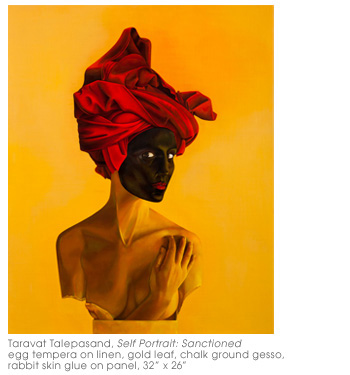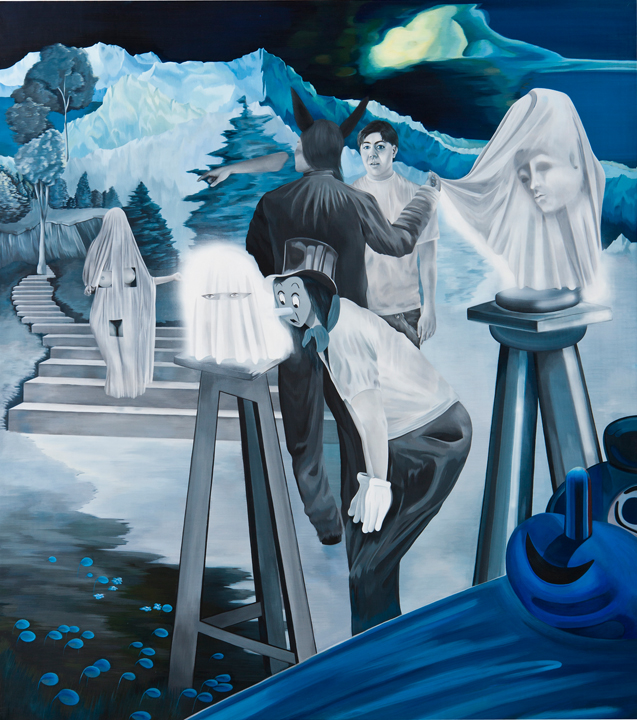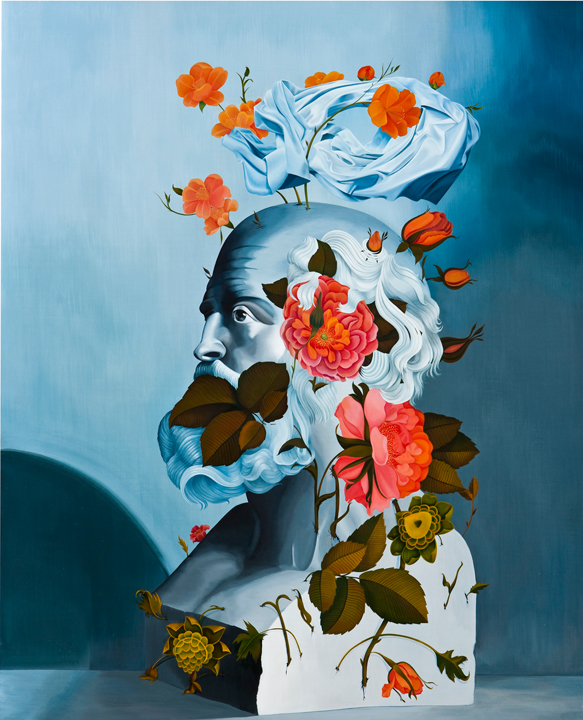"I am always an outsider looking in," says Iranian-American artist Taravat Talepasand. "By portraying myself in different cultures I start to understand how another culture might see, and where they might place me." Indeed Talepasand's current body of work, now on view at Steven Zevitas Gallery in Boston until June 11th, examines how the Eastern and Western cultures conflate and clash. Even the title of the show, The Corrupt Minority refers to a recent combative statement made by Iranian clerics that lightly veiled women are a corrupt minority. The irony of course is that Islamic legislation has made women legitimate sex objects and this is at the heart and core of Talepasand's recent body of work: issues of global and personal identity, sex and gender, and most specifically, that of the process of subject (Talepasand) as she is transformed and overtaken by objectification.
Image-making is by definition always a process of objectification; Talepasand extends this process by incorporating the use of self-portraiture into her work.

Image courtesy of Steven Zevitas Gallery
In the exquisitely crafted "Self Portrait: Sanctioned," Talepasand merges the traditions of European and Persian painting into a self-examination. As dark and mysterious as the Jan Van Eyck it alludes to, Talepasand re-appropriates not just the colors of that rich, red turban, but the invention of oil painting, a technique originally credited to Van Eyck and the Renaissance that, in point of fact, originated in the Middle East. Taking it one step further, Talepasand has painted herself naked, as a sculptural relic reminiscent of a pre-Islamic time. Her face is covered in black oil, the source of much of the value and conflict between her Western and Eastern identities, and she has truncated her image at the arms, though she still manages to shield her breasts from the viewer as she boldly stares out of the canvas.

Image courtesy of Steven Zevitas Gallery
"Still Life: Halft Sin" is a depiction of the tradition during the Persian New Year, to set up a table of meaningful objects, often grains, candles and The Koran. Unable to visit Iran because of the recent unrest, Talepasand sought connection through blogs and the internet. Online, she discovered an illicit and subverted culture, hidden from traditional view, much like women are hidden behind their burkas. She has appropriated some of these images into her own tableaux of relics, painting scandalous images of Iranian women posing nude that she found on these sites. Although the painting is quite risqué, the hookah in the center is an instrument allowed to both men and women of the culture, and the use of a female palette of pinks and reds softens and personalizes the explicit subject matter.

Image courtesy of Steven Zevitas Gallery
Using the play between darkness and light and images of pop, humorous puppetry, "Presumption of Justice" is a mythical commentary on the sinister repression of women in Iran. The painting is a complicated narrative of fairytale melded with contemporary culture. The three radiant female images representing the mind, body and soul of women. In the center of the picture, Talepasand, disguised under a Pinocchio mask gazes at the soul, draped and glowing up on a pedestal. Like the fictional Pinocchio -- a wooden puppet that wanted to be a "real boy" -- Talepasand, too, wishes to rescue the sculpture and turn it into a real woman. But unable to do the forbidden, she is transformed into a donkey cleric who stands with back to the canvas and scolds the only real boy in the picture: the man with the truncated arm who is pointing at the female image descending. For like a goddess leaving Mount Olympus, "woman" has climbed off her pedestal and returned to earth to warn and rescue her tribeswoman. In so doing, her private parts, those identifying her as female, have been exposed to the X-ray vision of the clerics as well as the viewer.
Talepasand's palettes are often separated between blues and grays for male depicted subject matter, and pinks and reds for female, a comment on the division between men and women within Iranian culture. In the painting Andarooni, Biooni, Lies and Man (Insider, Outsider , Lies and Man), these colors come together. Blooming bursts of orange and red vines -- feminine flowers -- are in the process of breaking through a stone cleric bust of cold blue. In depicting Andarooni Biooni, Talepasand is embracing her outsider insider status in the culture, as a woman and an Iranian/American.

Image courtesy of Steven Zevitas Gallery
Insisting on her right, even her ownership of taboo imagery, Taravat Talepasand re-appropriates the female form from both Iranian and American culture. By portraying subjects in moments of objectification she connects the personal to collective experience, thus her art becomes a lesson in the futility of ever truly erasing identity from society.